Mad Hedge Technology Letter
November 13, 2018
Fiat Lux
Featured Trade:
(NO BIWEEKLY STRATEGY WEBINAR FOR WEDNESDAY NOVEMBER 14)
(WHY I HATE CHIP STOCKS)
(AAPL), (CY), (TXN), (LRCX), (KLAC), (LITE), (QCOM), (MU), (SWKS), (LSCC)

Mad Hedge Technology Letter
November 13, 2018
Fiat Lux
Featured Trade:
(NO BIWEEKLY STRATEGY WEBINAR FOR WEDNESDAY NOVEMBER 14)
(WHY I HATE CHIP STOCKS)
(AAPL), (CY), (TXN), (LRCX), (KLAC), (LITE), (QCOM), (MU), (SWKS), (LSCC)

Now that the midterm elections are behind us, Congress will be gridlocked for the next two years portending well for tech stocks as a whole.
However, the gridlock will exacerbate negative sentiment in one small group of technology – the semiconductor chip sector.
I have been staunchly bearish on this cohort since the outset of the trade logjam with China and I recommend readers to avoid these stocks like the plague.
The split Congress could fuel an even more rigid stance towards the complicated tech situation, further clamping down on foreign IP theft and technological forced transfers.
Either way, there is no end in sight and as this administration is concretely in place for the next two years, doubling down on foreign policy wins could be the Republican party’s path to victory heading into the 2020 election.
This could mean the rhetoric towards China could ratchet up a few levels.
Soon enough, the tariffs levied on Chinese imports is set to increase to 25% in January.
Even before January, a planned meeting between Trump and Chairman Xi in Buenos Aires on Nov. 29 will take place and is creating a swirling tornado of uncertainty around chip sentiment that is on tenterhooks.
Any chance to resuscitate the sentiment in the industry could come and go with another gut-churning leg down in chip shares.
Unfortunately, the sword of Damocles hanging over the chip sector could drop in 2019 slashing profit margins, revenue, and damaging the all-important guidance.
Even if individual chip companies determine that the trade friction is too much to stomach, it would be expensive and lengthy to transfer an entire supply chain to Vietnam or Indonesia, hitting current R&D budgets and damaging future innovation affecting the pipeline of fresh products.
Time is not a friend to the chip sector.
If the China leveraged chip companies were to wait out this trade war, they risk further being enveloped into the eye of the trade storm if no quick agreements can be made.
They might have to wait a while as Beijing views waiting out Trump and dealing with the next administration in charge as the ideal option.
Chairman Xi conveniently removed term limits in the last congress, meaning he is in his job until death which could be another 40 years or so.
That is the time horizon the Chinese are playing with.
The timing couldn’t have been worse for the chip sector after a slew of weak guidance from upper management painted a downbeat picture for the sector as we inch towards 2019.
Texas Instruments (TXN) Chief Executive Rich Templeton started off his earnings report admitting, “demand for our products slowed across most markets.”
He later admitted that the semiconductor market is grappling with an imminent “softer” market.
Following up a growing chorus of chip executives flashing dangerous warnings signs, Lattice Semiconductors (LSCC) lamented that it was seeing slowness in the industrial and consumer markets in Asia as a result of macroeconomic conditions and tariffs.
Cypress Semiconductor (CY) also chimed in saying it was coping with “softness across the board.”
Making matters worse, Beijing has been showering capital on the local chip sector aimed at nurturing and developing Chinese chip companies poised to compete on the global stage.
Recently, Chinese state-backed semiconductor maker Fujian Jinhua Integrated Circuit was indicted by the U.S. Justice Department for industrial espionage.
The company allegedly stole trade secrets from Boise-based Micron (MU).
Micron could now become the first piece of collateral damage to the snarky trade war threatening huge swaths of American chip company's revenue.
And with the affected American chip companies waded in a quagmire, and chip market softness on the near horizon, semiconductor equipment firms have borne a good amount of the damage this year with Applied Materials Inc (AMAT), KLA-Tencor Corp (KLAC), and Lam Research Corp (LRCX) getting hammered.
Chips tied to Apple’s (AAPL) iPhone are also in for a drubbing with Apple suddenly announcing in their most recent report they would stop offering the unit sales of iPhones, creating more uncertainty around units sold for a massive end-market for global chip companies, adding to the swirling uncertainties overall Chinese chip revenue face.
Apple proxy chip stocks who lean on Apple for a big chunk of revenue such as Skyworks Solutions (SWKS) are getting crushed.
Skyworks was downgraded last week by Citigroup based on underperforming iPhone XR sales.
The rapid rush of chip downgrades has been fast and furious.
Skyworks will have pockets of strength when 5G is fully rolled out because they will supply critical components installed in this new technology for the new era of internet speed and performance.
But that pocket of strength is not now and will not happen tomorrow.
It’s time to duck out of Skyworks and I have been convincingly downbeat on this particular name since the inception of the trade war.
Today crawled in the next batch up negative chip news from Lumentum Holdings (LITE) who supplies 3D chips for Apple iPhone's facial recognition system.
Management reported that sales would be $20 million lower than originally forecasted because of a sudden reduction in shipments from an unnamed customer.
Another ongoing headache is the Qualcomm (QCOM) versus Apple marriage or divorce, depending on how you look at it.
They have been mired in a prolonged court case against each other, and Qualcomm’s share price has been dismal as of late.
Qualcomm recorded zero licensing revenue in the quarter from Apple who is withholding royalty payments from Qualcomm in a dispute over the company's licensing practices.
The move damaged quarterly licensing sales sliding 6% to $1.14 billion.
Qualcomm has lashed back at Apple pointing the finger at Apple for transferring its intellectual property to Intel (INTC) who is supplying chips for new-model iPhones which is possibly part of the reason they lost this contract.
Losing the iPhone contract to Intel is the main factor in Qualcomm expecting modem chip shipments to decline 22% to about 185 million units.
The fight has no end in sight but like Skyworks Solution, Qualcomm is on the forefront of the 5G revolution and provides a silver lining to embattled revenue growth that has been dragged down with the China mess.
At the end of the day, companies have less resistance when they aren’t belligerently brawling with their biggest purchasers.
Biting the hand that feeds you is a poor strategy that cuts across any industry.
Avoid chip companies for the short term and wait for sentiment to reverse course.
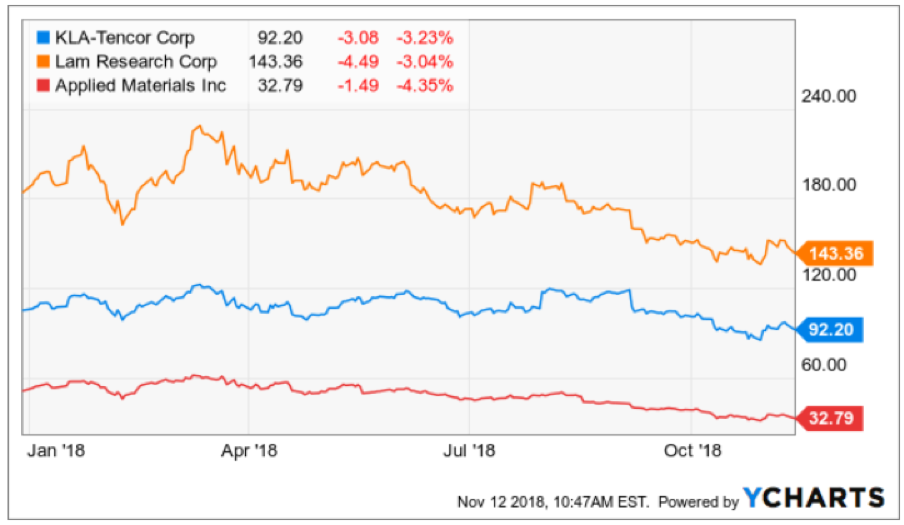
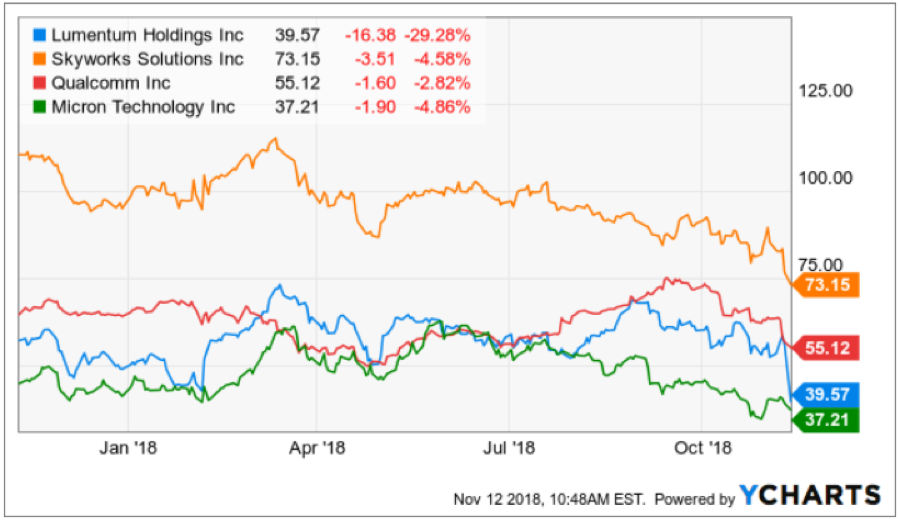
Mad Hedge Technology Letter
September 24, 2018
Fiat Lux
Featured Trade:
(BAD NEWS FROM MICRON TECHNOLOGY (MU),
(MU), (BABA), (KLAC), (LRCX), (INTC), (AMD), (NVDA), (HPQ)

If your stomach was on edge before, then you must feel quite queasy now.
That’s only if you didn’t get rid of your chip stocks when I told you to.
The chip sector has been rife with issues for quite some time now, and I’ve been firing off bearish chip stories the past few months.
Intel (INTC) was one of the last chip companies I told you to avoid like the plague, please click here to review that story.
The contagion has spread wider.
Micron (MU), the Boise, Idaho-based chip giant, delivered poor guidance from its latest earnings report, adding more carnage to this trouble sector.
It’s been rough sailing for many American-based chip companies lately that are not named Advanced Micro Devices (AMD) and Nvidia (NVDA).
The protracted ongoing trade war between America and China that sees no end in sight is the fundamental reason to stay away from these chip companies that are the meat and potatoes inside of all electronic devices.
Cofounder of Alibaba (BABA) Jack Ma, who recently stepped down from his position as chairman, told news outlets that this trade war could last “20 years” and is “going to be a mess.”
Micron is affected by this trade war more than any other American company, with half of its annual revenue derived from the Middle Kingdom.
Out of the $20.32 billion in annual revenue last year, more than $10 billion was from China alone.
Micron is a leader in selling DRAM chips, which are placed in most portable electronic devices such as smartphones, video game consoles, and laptop computers.
The commentary coming out from chip executives has been overly negative and spells doom and gloom - supporting my view to be cautious on chips through the end of the year.
At the Citi 2018 Global Technology Conference in New York, KLA-Tencor (KLAC) chief financial officer Bren Higgins characterized the winter season DRAM market as “little less than what we thought,” describing margins as “modestly weaker.”
Lam Research (LRCX), once one of my favorite chip plays, offered bearish rhetoric about the state of chip investments, saying on its earnings call that is expected “lower spending on new equipment by some of its memory customers.”
It doesn’t take a rocket scientist to know that “memory customer” is Intel, which is in the throes of a CPU chip shortage rocking the overall personal computer market.
Personal computers face a steep 7% drop in sales volume for the rest of the year, and the knock-on effect is rippling throughout the industry.
The lower volume of produced computers means less memory needed, adding up to less sales for Micron.
This rationale forced Micron to guide down its revenue growth from 22% to 16% for the last quarter of 2018.
Intel’s monumental lapse has offered a golden opportunity for competitor Advanced Micro Devices (AMD) to steal market share from Intel in broad daylight.
This was the exact thesis that provoked me to urge readers to pile into AMD shares like a Tokyo rush-hour subway car.
Shares have gone ballistic to say the least.
(AMD) is poised to seize and reposition itself in the global CPU market with a 70/30 market share, up from the paltry 90/10 market share before Intel’s debacle.
To make matters worse for Intel, widespread reports indicate its shortage problems are “worsening.”
Such is a dog-eat-dog world out there when a company can triple market share in a blink of an eye.
The rotation is real with HP (HPQ) planning to integrate AMD chips into 30% of its consumer PCs, and Dell already mentioning it will use AMD chips to make up for the shortages.
The resilience in chip demand remains the silver lining for this industry as price weakness and production shortages will be finite.
Server demand remains particularly robust.
Google, Amazon, Facebook, and Microsoft coughed up $34.7 billion on data centers to serve cloud-based operation in the first half of the year in 2018, a sharp increase of 59% YOY.
Investors have been paranoid of the boom-bust nature of the chip industry for decades.
Each cycle sees spending and chip pricing rocket, only for inventories to build up and demand to evaporate in an instant.
The beginning of the end always starts with lower guidance, followed up with missed earnings the next quarter.
This playbook has repeated itself over and over.
Micron guided first quarter revenue of 2019 in a range between $7.9 billion to $8.3 billion, lower than the consensus of $8.45 billion.
And, if all of this horrid chip news wasn’t reason to rip your hair out - here is the bombshell.
To wean itself off the reliance of American chips, Alibaba has created a subsidiary to produce its own chips called Pingtouge Semiconductor Company.
Pingtouge refers to honey badger in the Chinese language, symbolic for its tenacity in the face of adversity – perhaps a thinly-veiled dig at the American political system.
Former Chairman Ma pocketed this chip company Hangzhou C-SKY Microsystems last year. It will will be given ample leeway and resources to team up with Alibaba to roll out its first commercial chip next year.
Alibaba has rapidly grown into the third-largest cloud player in the world, and require an abundant source of chips moving forward.
Chips tricked out with artificial intelligence will be adopted by not only its data centers, but integrated with its autonomous driving technology and IoT products, which are markets that Alibaba is proud to be part.
You can find Alibaba’s cloud products present in more than 20 countries. And the company that Jack Ma built forecasts to generate more than 50% of its revenue from overseas markets soon.
It could be Jack Ma laughing all the way to the bank.
Ultimately, Micron produced fair results last quarter, but like Facebook found out, if investors believe the company is about to fall off a cliff, it offers little resistance to the share price on a short-term basis.
Could the cyclicality demons start to awake to drag this company down?
Partially, yes, but there are still many positives to take away from this leading chip company.
China will need years to remedy its addiction of American chips.
It will not be able to produce the scope of quality or quantity to just stop buying from American companies for the foreseeable future.
The authorized $10 billion share buyback gave Micron shares a nice lift earlier this year, but the industry dynamics are now deteriorating rapidly.
Chip sentiment is at its lowest ebb for some time, and I reaffirm my call to avoid this sector completely unless it’s the two cornerstone chip companies showing systematic resiliency - (AMD) or Nvidia (NVDA).
The administration initially slapped on a tariff rate of 10% on $200 billion worth of goods with intentions to scale it up.
If nothing is solved, the increase to 25% will cause another 5% to 10% drop in Micron and Intel.
Then if the administration plans to go after the rest of the $250 billion of Chinese imports, expect another dive in chip shares.
Either way, each jawboning tweet as we head deeper into this trade conflict will damage Micron’s shares.
This sector is getting squeezed from many sides now, and if you don’t go outright short chip companies, then stay away until the storm clouds pass over and you can reassess the situation.
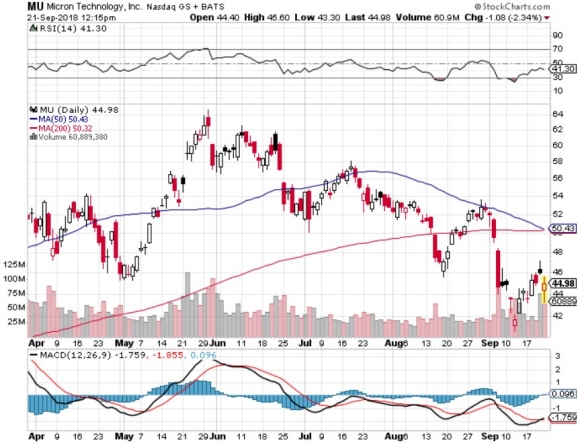
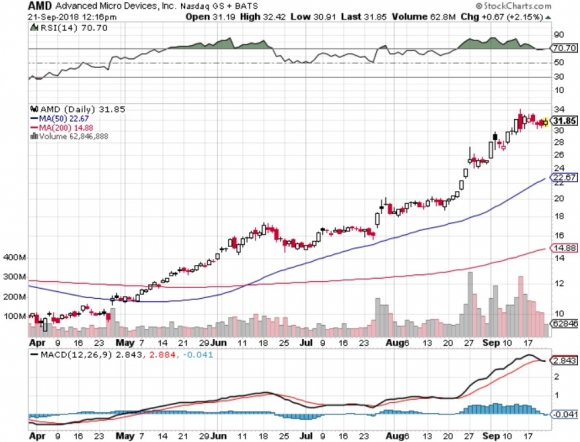
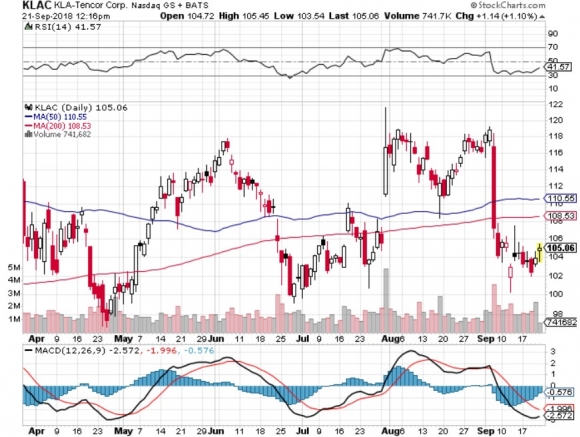
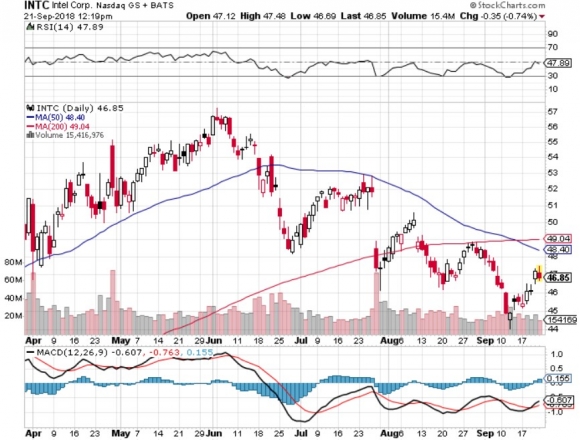
Global Market Comments
September 13, 2018
Fiat Lux
Featured Trade:
(EXPANDING MY “TRADE PEACE” PORTFOLIO),
(BABA), (BIDU), (TCTZF) (MU), (LRCX), (KLAC), (EEM),
(FXI), (EWZ), (SOYB), (CORN), (WEAT), (CAT), (DE),
(THE LEAGUE OF EXTRAORDINARY TRADERS)

This morning, U.S. Treasury Secretary Steven Mnuchin mentioned that an effort was being made to get trade talks with China back on track. The Dow soared 160 points in a heartbeat.
Past murmurings by the Treasury Secretary demonstrate that his musings have zero credibility in the marketplace and the move vaporized in minutes. However, given the extreme moves made by the shares of trade war victims, I think it is time to review my “Trade Peace” portfolio and make some additions.
The shares have been so beaten up that I think you can start scaling in now with limited downside and a ton of potential upside.
It’s not a matter of if, but when Trump has to run up the white flag with his wildly unpopular trade wars. As they now stand the new tariffs are threatening to chop $10 off of S&P 500 earnings in 2018, from $168 down to $158, according to J.P. Morgan. Some two-thirds of all U.S. companies have been negatively impacted.
Tariffs have effectively wiped out the benefits of the corporate tax cuts for most companies enacted last December. Who has been the worst hit? Thousands of small manufacturers in Midwest red states that can’t function because they are missing crucial cheap parts they can only obtain from the Middle Kingdom.
At last count there are a staggering 37,000 applications for exemptions from tariffs filed with the U.S. Treasury and only a dozen people to process them. A mere 10% have been granted. It is a giant bureaucratic nightmare.
With the midterm elections now only 37 trading days away, the clock is ticking. If Trump doesn’t cut trade deals with all of our major counterparties around the world before then, the Republican Party stands to lose both the House of Representatives and the Senate on November 6. That will make Trump a “lame duck” president for two more years.
China Technology Stocks – Includes Alibaba (BABA), Baidu (BIDU), and Tencent (TCTZF). It’s not often that you get to buy a company with 61% sales growth, which has seen its shares plunge by 27% in three months, as is the case with (BABA). Just to get (BABA) back up to its June level it has to rise by 37%. This is a stock that will easily double or triple over the long term.
U.S. Semiconductor Stocks – With China buying 80% of its chips from the U.S., stocks such as Micron Technology (MU), Lam Research (LRCX), and KLA-Tencor (KLAC) have been taken out to the woodshed and beaten senseless. Micron is off a withering 41% since the trade war began in earnest in May.
Emerging Markets – China is the largest trading partner for most of the world, and a recession there sparks a global contagion effect. Reverse that, and you stimulate not only emerging markets, but the U.S. economy, too. Look at the charts for the iShares MSCI Emerging Markets ETF (EEM), the iShares China Large-Cap ETF (FXI), and the iShares MSCI Brazil ETF (EWZ) and you will salivate.
Oil – Boost the global economy and oil demand (USO) also. China is the world’s largest incremental buyer of new oil, and it will absorb all of the Iranian crude freed up by the U.S. abrogation of the treaty there.
Agricultural – No sector has been punished more than agriculture, where profit margins are small, lead times stretch into years, and mother nature plays her heavy hand. In this area you can include soybeans (SOYB), corn (CORN), and wheat (WEAT), as well as equipment makers Caterpillar (CAT) and Deere (DE).
Some 20 years of development efforts in China by American farmers have gone down the toilet, and much of this business is never coming back. Trust and reliability are gone for good. Storage silos across the country are full. Did I mention that red states are taking far and away the biggest hit? There are not a lot of soybeans grown in California, New York, or New Jersey.
Even if Trump digs in and refuses to admit defeat, as is his way, there is still a light at the end of the tunnel. Sometime in 2019, the World Trade Organization will declare virtually all of the new American tariffs illegal and hit the U.S. with its own countervailing duties. This is the Chinese strategy. Waiting for them to fold could be a long wait, a very long wait.


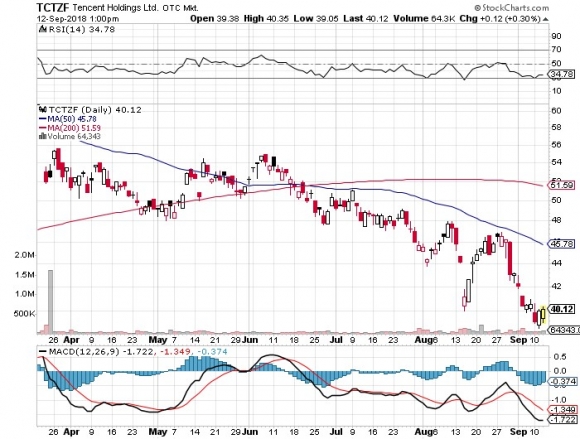
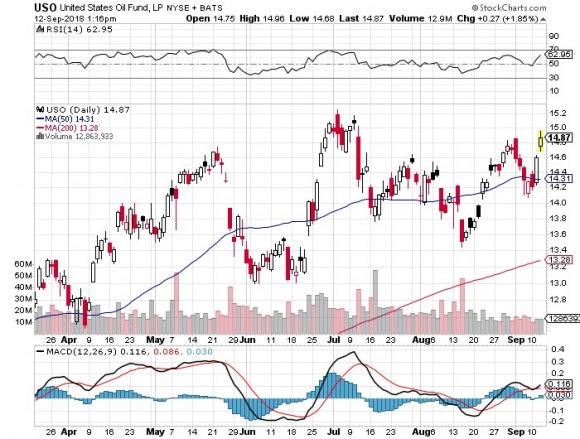
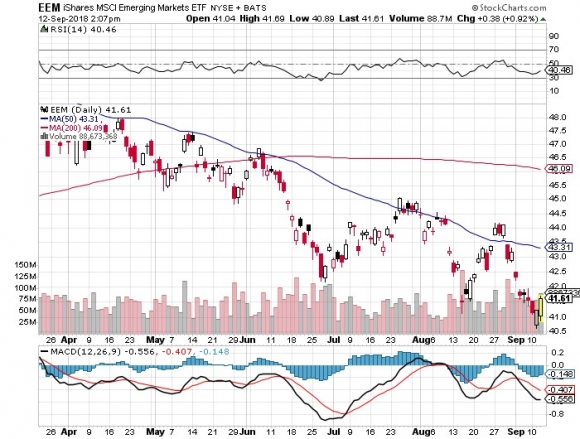
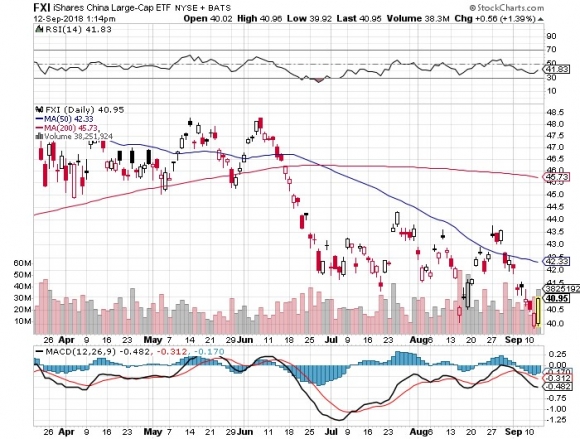
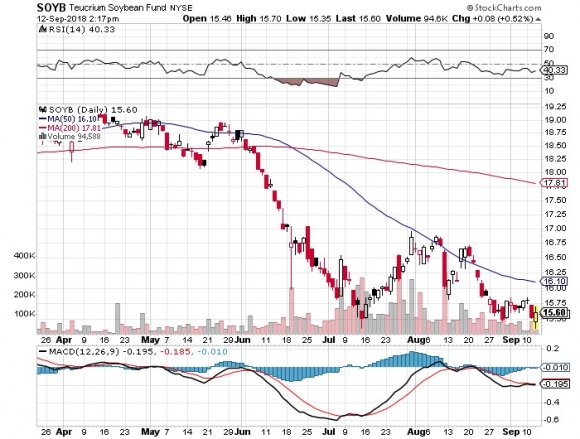

Legal Disclaimer
There is a very high degree of risk involved in trading. Past results are not indicative of future returns. MadHedgeFundTrader.com and all individuals affiliated with this site assume no responsibilities for your trading and investment results. The indicators, strategies, columns, articles and all other features are for educational purposes only and should not be construed as investment advice. Information for futures trading observations are obtained from sources believed to be reliable, but we do not warrant its completeness or accuracy, or warrant any results from the use of the information. Your use of the trading observations is entirely at your own risk and it is your sole responsibility to evaluate the accuracy, completeness and usefulness of the information. You must assess the risk of any trade with your broker and make your own independent decisions regarding any securities mentioned herein. Affiliates of MadHedgeFundTrader.com may have a position or effect transactions in the securities described herein (or options thereon) and/or otherwise employ trading strategies that may be consistent or inconsistent with the provided strategies.
This site uses cookies. By continuing to browse the site, you are agreeing to our use of cookies.
OKLearn moreWe may request cookies to be set on your device. We use cookies to let us know when you visit our websites, how you interact with us, to enrich your user experience, and to customize your relationship with our website.
Click on the different category headings to find out more. You can also change some of your preferences. Note that blocking some types of cookies may impact your experience on our websites and the services we are able to offer.
These cookies are strictly necessary to provide you with services available through our website and to use some of its features.
Because these cookies are strictly necessary to deliver the website, refuseing them will have impact how our site functions. You always can block or delete cookies by changing your browser settings and force blocking all cookies on this website. But this will always prompt you to accept/refuse cookies when revisiting our site.
We fully respect if you want to refuse cookies but to avoid asking you again and again kindly allow us to store a cookie for that. You are free to opt out any time or opt in for other cookies to get a better experience. If you refuse cookies we will remove all set cookies in our domain.
We provide you with a list of stored cookies on your computer in our domain so you can check what we stored. Due to security reasons we are not able to show or modify cookies from other domains. You can check these in your browser security settings.
These cookies collect information that is used either in aggregate form to help us understand how our website is being used or how effective our marketing campaigns are, or to help us customize our website and application for you in order to enhance your experience.
If you do not want that we track your visist to our site you can disable tracking in your browser here:
We also use different external services like Google Webfonts, Google Maps, and external Video providers. Since these providers may collect personal data like your IP address we allow you to block them here. Please be aware that this might heavily reduce the functionality and appearance of our site. Changes will take effect once you reload the page.
Google Webfont Settings:
Google Map Settings:
Vimeo and Youtube video embeds:
